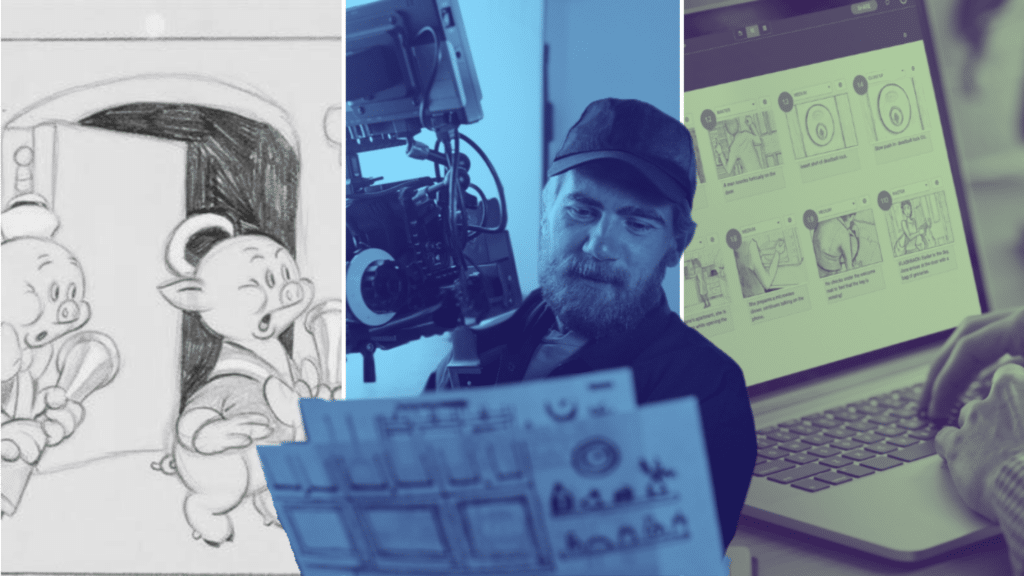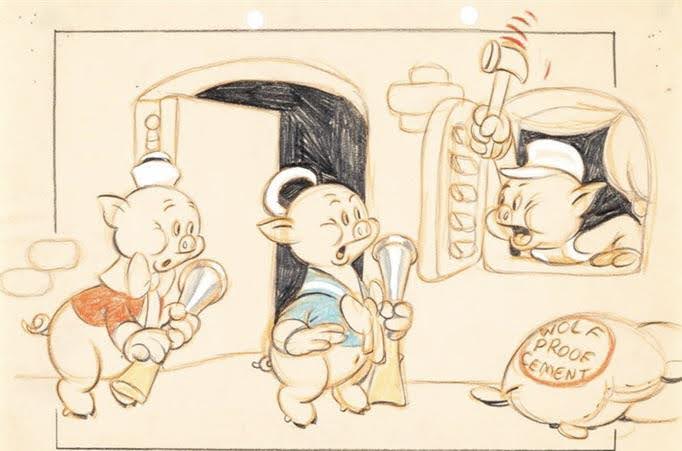
With the significant advancements of AI technology in recent years, its use in the creative industries has been a tenuous subject, and just one of the many considerations of the writers’ strike last year.
There is no denying, however, that AI has a place to enhance the speed and efficiency of the film production process. This includes storyboarding, one of the integral early stages of bringing a movie to the screen.
While AI may be relatively new technology in the grand scheme of things, storyboarding has long been one of the foundations of filmmaking, its roots tracing back to early animation studios of the 1930s, such as Disney.
The storyboard, as we know it, originated from the 1933 short, The Three Little Pigs.

Since the 1930s, the storyboarding process has evolved from hand-drawn sketches on paper to digital formats. This means artists can easily collaborate, make quick revisions, and integrate their storyboards with other production stages and software.
While technology has evolved, as well as the increased pace of film production, the core principle of storyboarding remains the same: crafting visual narratives that map out the flow of scenes. Despite the new involvement of AI in the process, human creativity continues to lead the charge.
But how can we use AI in an effective and healthy way that we maintain our creativity as filmmakers? In today’s article, we’ll explore the role of AI in modern storyboarding, how human creativity is still at the forefront of everything we do, and how you can use AI as an aid to your own storyboarding exploits.
Open To Debate: Will AI Kill the Future of the Creative Arts?
The role of AI and technology in storyboarding today
It’s no secret that crafting a storyboard takes a lot of time, with every individual frame sketched out and refined. Each frame can take anywhere from ten to twenty minutes to complete. With the average storyboard consisting of four to six frames per minute, that’s three-hundred-and-sixty frames for a ninety-minute feature, and sixty hours’ work (and that’s the minimum).
In modern filmmaking, productions are constantly trying to become more efficient in their outputs. AI can be invaluable in streamlining the sketching, animatics, and layout processes. This helps the artists focus on the creative storytelling, rather than repetitive tasks.
AI can automatically generate sketch, animatic and layout suggestions, reducing the time it takes from concept to visual plan. This doesn’t, of course, mean that AI is replacing the animator, but rather complementing the vision they have for the overall storyboard.
The human aspect is irreplaceable; only the animator themselves can capture the nuances, emotions and narrative subtleties within their storyboard that make a story compelling.
“Animation Means To Invoke Life, Not To Imitate It.” – Chuck Jones (Looney Tunes, How the Grinch Stole Christmas!, Horton Hears a Who!)
A variety of AI-assisted tools have emerged, offering a blend of automation and creative flexibility. Storyboard Pro, Boords, and others include workflow features like automatic shot suggestions and frame layouts, while here at Celtx, we allow you to enjoy the efficiency of automation while leaving the creative control in your hands!
Want to learn more about the storyboarding software out there? Make sure to check out our top picks for the Best Storyboarding Software [For all Budgets].
Human creativity still leads the charge
As we’ve previously mentioned, AI is a great tool to use to improve productivity. However, human creativity and intuition are what brings our stories to life.
While AI can make suggestions, instantly iterate a frame, or perform quick revisions, it’s the animators themselves who refine and manually draw the more complex compositions to achieve a specific vision.
AI doesn’t have the capacity to grasp emotion, nuance and subtle cues, so we, as human creators, are the ones who are responsible for this. Here at Celtx, we know the importance of maintaining control of your work, with integrated visual elements, orientation, layers and layouts. Check out our storyboarding tutorial in our post here.
Related reading: The art of storyboarding: Enhancing script breakdown and pre-production in filmmaking || FILMUSTAGE
AI as an Aid, not a Replacement
“With great power, comes great responsibility.” – Voltaire (or Uncle Ben in Spiderman (2002)!)
AI and automated software elements have proven to be hugely successful, and when used responsibly, they can produce amazing results.
Take The Mandalorian (2019-Present), which used revolutionary virtual technology to save not only on time, but also on physical materials when it came to shooting the first season. Creator, Jon Favreau, collaborated with Industrial Light and Magic, and Epic Games to build a virtual production stage and workflow. Everything was created within Unreal Engine.

This entailed creating live dynamic digital landscapes to be displayed behind the actors on an LED wall as they were filming. With fifty percent of season one being filmed in this way, it eliminated the need for filming on multiple locations.
The LED wall was able to create the required reflections and lighting on the actors and surrounding set pieces, saving time in post-production and editing.
Don’t fear AI—use it to handle the repetitive tasks while
Celtx helps you craft your creative vision.
start storyboarding with our free templates!
The use of such technologies wouldn’t have taken away from the human artistry needed to envision and sketch out these scenes in the first instance, but more so enhanced the later stages, allowing the crew to focus on filming and ensuring the emotion and nuances of the action were captured, rather than the technicalities and time to search for locations. Plus, it would have saved the expense of logistics at sometimes unforgiving and remote locations.
Check out this informative video from ILM about the process of bringing some of the most breath-taking scenes from The Mandalorian to life.
Animation studios are also creating their own technology to assist with their unique requirements. For example, media company Animaj, based in Paris have developed their own model that helps address non-human body proportions for children’s characters, and character adaptation models to make their workflow easier.
One example of their innovation is text-to-3D motion, which allows artists to edit scenes in real time, with a character pre-loaded into the environment. While AI has done the heavy lifting, it allows the Animaj animators to maintain control and focus on the creative vision.
Visual storytelling trends in 2025
In recent times, storyboarding has seen a rise of virtual production and AR/VR integration, particularly in pre-production. Virtual reality tools are starting to influence how directors and storyboard artists visualize scenes, enabling them to step inside their storyboards in a three-dimensional space.
Michaela A. Ternasky-Holland is an Emmy award-winning director who specializes in utilizing immersive and interactive technology to bring her stories to life. She is a trailblazer in XR (expanded reality) storytelling, and explains in an interview with NAB Amplify that:
“It’s early days for the medium and people make mistakes, as well as good work. But because the hardware keeps improving, we’re going to start to see a rise in spatial storytelling.”
XR technology allows for more immersive storytelling by blending virtual elements with physical spaces, so the animators can see everything in real time. This isn’t only useful for saving time, but also allows real-time feedback from other stakeholders in the project, such as the director and producer.
You may have noticed us name-dropping Unreal Engine, which funnily enough, is used primarily in the games industry. However, gaming engines like this are being used more and more in film, TV and even advertising, where real-time feedback is essential for adjusting scenes on the fly.
Of course, the human element remains at the forefront, ensuring visual continuity, and the overall atmosphere and emotional tone of the original writing are front and center of the project’s focus.
How AI can support your Celtx storyboards
It’s crucial that when AI is utilized, it shouldn’t limit the user’s creativity or input. With our software suite at Celtx, we ensure our features are only there to streamline your storyboarding creation.
We allow you to quickly populate storyboards using our extensive image library, cutting down on time researching for visual sources. Our platform will never override your vision, only help you to achieve the best version of it.
Here’s how you can use our storyboard to create a visual representation of your screenplay:
For even more on storyboarding and bringing your vision to life, check out our dedicated storyboarding page and free template here. We’re always here to help!
The Future of Storyboarding, a Hybrid Approach
We don’t have a crystal ball, of course, but the future of storyboarding is likely to continue to blend traditional methods with advanced AI technologies, virtual production and real-time rendering.
As production timelines tighten and digital tools become more sophisticated, this hybrid approach will probably dominate over the next few years.
In the future, we can expect AI to continue to evolve in its ability to assist with scene layouts and predict camera movements, though it will still be human artists who bring emotional depth and nuance to complex scenes. AI will serve as a tool to improve efficiency, but it won’t replace manual drawing in situations that require intricate visual storytelling or artistic interpretation.
As AR and VR continue to develop, pre-visualization tools will expand, which will mean artists and directors can collaborate in fully interactive environments. This could radically change how teams visualize and plan their shots, enabling them to adjust lighting, scene composition, and even scene blocking virtually.
Despite the growth of AI technology, the most successful productions will likely be those that effectively combine the efficiency of AI with the creativity and storytelling skills of human artists. As we’ve explored, studios like Pixar, DreamWorks, and live-action productions like The Mandalorian are already adopting this hybrid approach, and it’s poised to become the standard across the industry.
Conclusion
When it comes to blending AI and traditional methods in storyboarding, you shouldn’t feel like you’re being pulled in two directions. Yes, AI is evolving quickly, and it can feel like it’s literally taking over everything, but don’t worry, there’s room for both. The key is finding a balance that works for you.
Think of AI as your assistant who takes care of those time-consuming, menial tasks like generating rough drafts or suggesting layouts, giving you more space to focus on what matters: creativity, emotion, and storytelling. Our tools at Celtx are a great example, offering automation features that streamline your workflow, but never take away your control over the final product.
Simultaneously, traditional methods, like hand-drawing storyboards, are still crucial in bringing out the finer details of your story. Whether it’s capturing complex emotions or creating intricate scene compositions, nothing beats the human touch for those artistic decisions.
So, don’t be afraid to experiment. Let AI help you where it makes sense and use traditional techniques to dive deep into your creative vision. It’s not about choosing one over the other. It’s about combining the best of both worlds to make your workflow faster, smoother, and more creative.
There’s no need to feel stuck in the past or worried about what the future holds, even if it’s moving at lightning speed. Embrace both AI and traditional methods, and you’ll find your storytelling flow with tools like Celtx that are designed to help you balance it all.
Want to talk more about storyboarding? Follow us on our socials and get in on the conversation!
Read these next:
- 999 Short Story Ideas by Celtx (To Help You Get Started)
- Non-Linear Storytelling | Definition, Benefits, and Tips
- The Bear, The Batman, and Barbie: Starting Strong in Storytelling


